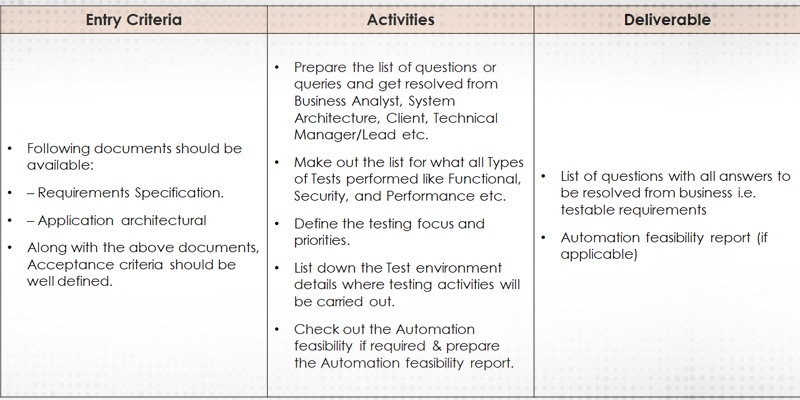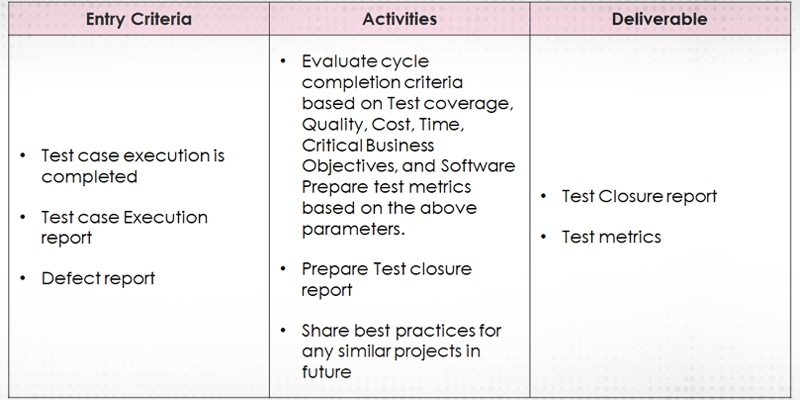25
JulGrab Deal : Flat 30% off on live classes + 2 free self-paced courses - SCHEDULE CALL
Like the Software Development Life Cycle (SDLC), the Software testing Life cycle comprises various distinct phases such as requirement analysis, test planning, test case development, test environment setup, test execution, test cycle closure and many more.
In today’s developing world, Software testing is at the core of unusual digital experiences. In case you are not able to thoroughly validate your products before your clients use it, you risk estranging them.
Let us get you straight through that Software testing isn’t just a process to pursue before product delivery. Rather it is a multi-faceted, organization wide and ongoing effort to deliver the best product. This can be better explained by our career experts through an extensive QA Software testing training program that will impart every basic to advanced learning to make you ready for the industry.
Just as SDLC, it is necessary for developing digital products and STLC is used for validating them efficiently for smooth delivery. Despite that, the process includes multiple members of organization at different levels to help businesses achieve their required quality goals in a specific manner.
So, now after getting a small intro about STLC, it's time to understand about What is software Testing life cycle? In brief!
Software Testing Life Cycle (STLC) is the testing procedure which is executed in an orderly and arranged way. In the STLC procedure, various exercises are done to improve the nature of the item. It is a sequence of some specific activities that are conducted during the testing process to ensure that the professional team meets the software quality goals.
The Software Testing Life Cycle (STLC) includes both verification and validation activities to help certify your software product.
Now you must have understood that the STLC is a set of measures and it includes various stages, like planning, control, implementation, standardization, and so on to fulfil your product requirements. All these things leads us to the fact that the Software Testing Life cycle is required not only to test the developed product quality but also for the following things that are mentioned here, such as:
Moreover, the overall goal of STLC is client satisfaction and achieving the highest possible score at the Verification and Validation stages.
Here the picture depicts the role of the STLC in the SDLC with a double line graph:
As mentioned earlier, the Software Testing Life Cycle (STLC) and the Software Development Life Cycle (SDLC) are closely related to each other, but they simultaneously pursue different tasks of the same goal, such as:
Moreover, the overall goal of STLC is client satisfaction and achieving the highest possible score at the Verification and Validation stages.
Join our QA testing community and learn more on how STLC and SDLC are interrelated and yet different from each other.
Here the picture depicts the role of the STLC in the SDLC with a double line graph:

In the above picture, the SDLC and the STLC lines move in parallel for most of the projects but start during the SDLC Test phase. Thiconverging instantly during the software development phase with in-depth synchronization s graph is pertinent to multiple types of projects such as software development and testing. The process remains the same for the implementation of a task within a project and reverse for a project with a huge number of iterations for both large as well as small business projects. But in this case, the lines will diverge and converge more instant!
In the basic periods of STLC, while the item thing or the application is being made, the testing bunch examines and describes the degree of testing, area and leave criteria and the trials. It helps with reducing the test procedure length and besides redesign the item quality.
At the point when the advancement organize is done, the group is set up with experiments and starts the execution. This helps in finding bugs in the beginning time.
QA Software Testing Training

STLC has the accompanying various stages however it isn't required to follow all stages. Stages are reliant on the idea of the product or the item, time and assets designated for the testing and the model of SDLC that will be followed. Here’s a brief description of the phases of STLC-

Requirement Analysis is the absolute first stage in Software Testing Life Cycle (STLC) and it begins when the SRD/SRS is imparted to the testing group.
Right now, the group experiences the Requirement archive with both Functional and non-functional subtleties so as to recognize the testable necessities. ‘Requirement analysis’ phase helps in deciding and preparing in case any mitigation strategy is required.
QA Software Testing Training

On the off chance that any contention, missing or not saw any prerequisite, at that point QA group catch up with the different partners like Business Analyst, System Architecture, Client, Technical Manager/Lead and so on to all the more likely comprehend the nitty-gritty information on necessity.
From absolute initial step QA associated with the where STLC which assists with forestalling the bringing deserts into Software under test. The prerequisites can be either Functional or Non-Functional like Performance, Security testing. Likewise, prerequisite and Automation attainability of the venture should be possible right now (if applicable)

Test Planning is the most significant period of Software testing life cycle where all testing systems are characterized. This stage is likewise called the Test Strategy stage. All the features in the testing activities are planned and put into a document this is called ‘test planning’. Right now, Test Manager (or Test Lead dependent on organization to organization) is required to decide the exertion and quotes for the whole venture. This stage will be commenced once the necessity gathering stage is finished and dependent on the prerequisite investigation, and begin setting up the Test Plan. The Result of Test Planning stage will be Test Plan or Test system and Testing Effort estimation archives. When the test arranging stage is finished the QA group can begin with test cases development activity. Become a job-ready with the Self-learning QA software testing course and get practical as well as project-based knowledge.
Learn QA Software Testing in the Easiest Way


The test case development activity is begun once the test arranging action is done. This is the period of STLC where testing groups record the definite experiments. Alongside experiments, the testing group likewise set up the test information if any required for testing. Test cases are written for all the newly implemented features that need to be tested. When the experiments are prepared then these experiments are inspected by peer individuals or QA lead.
Likewise, the Requirement Traceability Matrix (RTM) is readied. The Requirement Traceability Matrix is an industry-acknowledged configuration for following prerequisites where each experiment is mapped with the necessity. Utilizing this Requirement Traceability Matrix we can follow in reverse and forward detectability.

Setting up the test condition is an essential piece of the STLC. Essentially, the test condition chooses which conditions programming is tried. This is a free movement and can be begun corresponding with Test Case Development. During the time spent setting up a testing domain, the test group isn't engaged with it. In light of an organization to organization might be an engineer or client makes the testing condition. In the meantime, the testing group ought to set up the smoke test cases to check the status of the test condition arrangement. While deciding the environment all hardware and software details are taken into consideration like which Operating system to use, how many servers should be involved, memory space, test drivers, stubs, testing data.

When the arrangement of Test Case Development and Test Environment arrangement is finished then the test execution stage can be commenced. Right now the group begins executing experiments dependent on arranged test arranging and arranged experiments in the earlier advance.
When the experiment is passed then the equivalent can be set apart as Passed. On the off chance that any experiment is fizzled, at that point the relating deformity can be accounted for to the engineering group by means of the bug following framework and bug can be connected for the comparing experiment for additional investigation. In a perfect world, each bombed experiment ought to be related within any event to a solitary bug. Utilizing this connection we can get the bombed experiment with a bug related to it. When the bug is fixed by the advancement group then a similar experiment can be executed dependent on your test arranging.
QA Software Testing Training

On the off chance that any of the experiments are hindered because of any imperfection, at that point such experiments can be set apart as Blocked, so we can get the report dependent on what number of experiments passed, fizzled, blocked or not run and so forth. When the imperfections are fixed, the equivalent Failed or Blocked experiments can be executed again to retest the usefulness.

Get out the testing colleague meeting and assess cycle fulfilment criteria dependent on Test inclusion, Quality, Cost, Time, Critical Business Objectives, and Software. Talk about what all went great, which region should be improved and take the exercises from the current STLC as a contribution to up and coming test cycles, which will assist with improving bottlenecks in the STLC procedure. Experiment and bug report will investigate to discover the imperfection dispersion by type and seriousness. When complete the test cycle at that point test conclusion report and Test measurements will be readied. Test outcome examination to discover the imperfection dissemination by type and seriousness.

Being a developer or software tester you must be aware of the fact that there is no time spare when it comes to testing. As it is important to meet the deadlines. Our professional QA teams should look for every edge while pursuing STLC to release high-quality products to their clients.
The professionals at JanBask help you serve your clients with expertise and exceptional products based on their desires. We make your testing process easy and open up additional opportunities like testing on a broader range of devices in different locations.
This lets you focus on What to test? Instead of How will you do it? From the beginning of the STLC, our professionals can present necessary QA questions to inform manual or automated QA strategy for a better product delivery.
Being professionals, we serve you with multiple services that help us fulfill your requirements on time such as enterprise-grade automation framework, manual testers in a particular market and with particular characteristics. These services help us serve you with ready to deliver products that exceed your testing goal.
FEEL FREE to share your Software Testing experience with us..via Comments!
 Pinterest
Pinterest
 Email
Email
She is an expert in writing informative blogs and article. She is best known for IT, Technical trends and career path education. Anusha has been producing distinctive and engaging content for the end-users.

Cyber Security

QA

Salesforce

Business Analyst

MS SQL Server

Data Science

DevOps

Hadoop

Python

Artificial Intelligence

Machine Learning

Tableau
Search Posts
Related Posts
LoadRunner Tutorial for Beginners – What all should you know?
![]() 7.9k
7.9k
Significance of Performance Testing in Ensuring Holiday Readiness of Apps
![]() 4k
4k
Considering QA Software Tester Career Path? Here’s Your Complete QA Career Guide
![]() 216.7k
216.7k
What is QAOps? A Beginner’s Guide to Bridging QA and DevOps for Faster Testing
![]() 420
420
Software Test Engineer Salary With Top Locations & Companies
![]() 4.6k
4.6k
Receive Latest Materials and Offers on QA Testing Course
Interviews